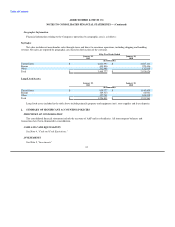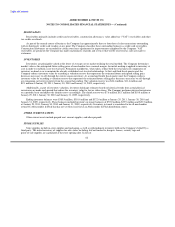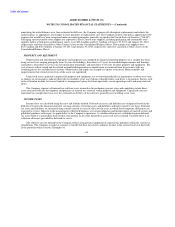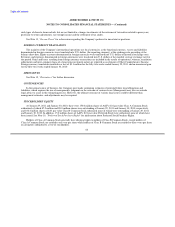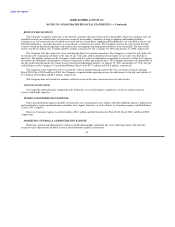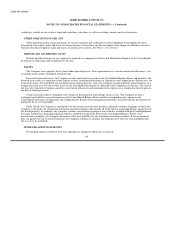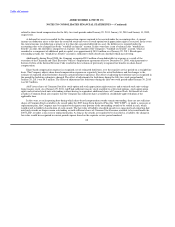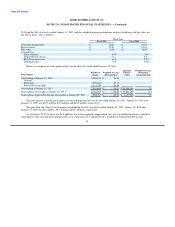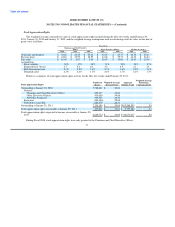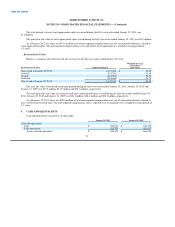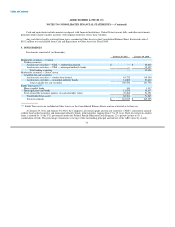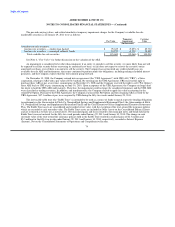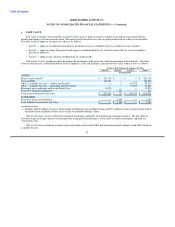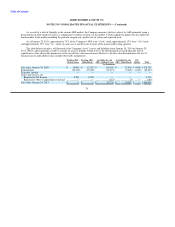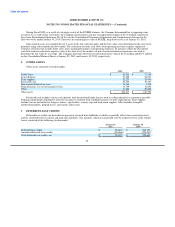Abercrombie & Fitch 2010 Annual Report Download - page 71
Download and view the complete annual report
Please find page 71 of the 2010 Abercrombie & Fitch annual report below. You can navigate through the pages in the report by either clicking on the pages listed below, or by using the keyword search tool below to find specific information within the annual report.
Table of Contents
ABERCROMBIE & FITCH CO.
NOTES TO CONSOLIDATED FINANCIAL STATEMENTS — (Continued)
related to share-based compensation for the fifty-two week periods ended January 29, 2011, January 30, 2010 and January 31, 2009,
respectively.
A deferred tax asset is recorded for the compensation expense required to be accrued under the accounting rules. A current
income tax deduction arises at the time the restricted stock unit vests or stock option/stock appreciation right is exercised. In the event
the current income tax deduction is greater or less than the associated deferred tax asset, the difference is required under the
accounting rules to be charged first to the "windfall tax benefit" account. In the event there is not a balance in the "windfall tax
benefit" account, the shortfall is charged to tax expense. The amount of the Company's "windfall tax benefit" account, which is
recorded as a component of additional paid-in capital, was approximately $83.8 million as of January 29, 2011. Based upon
outstanding awards, the "windfall tax benefit" account is sufficient to fully absorb any shortfall which may develop.
Additionally, during Fiscal 2008, the Company recognized $9.9 million of non-deductible tax expense as a result of the
execution of the Chairman and Chief Executive Officer's employment agreement effective December 19, 2008, which pursuant to
Section 162(m) of the Internal Revenue Code resulted in the exclusion of previously recognized tax benefits on share-based
compensation.
Share-based compensation expense is recognized, net of estimated forfeitures, over the requisite service period on a straight-line
basis. The Company adjusts share-based compensation expense on a quarterly basis for actual forfeitures and for changes to the
estimate of expected award forfeitures based on actual forfeiture experience. The effect of adjusting the forfeiture rate is recognized in
the period the forfeiture estimate is changed. The effect of adjustments for forfeitures during the fifty-two week period ended
January 29, 2011 was $4.5 million. The effect of adjustments for forfeitures during the fifty-two week period ended January 30, 2010
was $6.7 million.
A&F issues shares of Common Stock for stock option and stock appreciation right exercises and restricted stock unit vestings
from treasury stock. As of January 29, 2011, A&F had sufficient treasury stock available to settle stock options, stock appreciation
rights and restricted stock units outstanding without having to repurchase additional shares of Common Stock. Settlement of stock
awards in Common Stock also requires that the Company has sufficient shares available in stockholder-approved plans at the
applicable time.
In the event, at each reporting date during which share-based compensation awards remain outstanding, there are not sufficient
shares of Common Stock available to be issued under the 2007 Long-Term Incentive Plan (the "2007 LTIP"), or under a successor or
replacement plan, the Company may be required to designate some portion of the outstanding awards to be settled in cash, which
would result in liability classification of such awards. The fair value of liability-classified awards is re-measured each reporting date
until such awards no longer remain outstanding or until sufficient shares of Common Stock become available to be issued under the
2007 LTIP, or under a successor or replacement plan. As long as the awards are required to be classified as a liability, the change in
fair value would be recognized in current period expense based on the requisite service period rendered.
68





